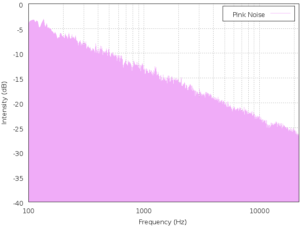Have you ever considered that noise—the unwanted, often unpleasant sound we usually think of as harmful—can actually have colors? Noise is a complex phenomenon with a whole spectrum of colors, each with its own unique characteristics and effects. For example, white noise is often used to mask other sounds just like Krisp does with its noise cancellation feature, while pink noise is believed to aid in better sleep. Let’s delve into the fascinating world of noise colors and explore each one.
What is Colored Noise?
Before discussing each color further, let’s define colored noise. In different fields like audio engineering, electronics, and physics, a noise’s power spectrum, which includes its strength and frequency, is described by its color. Sound travels in waves, which might be low-frequency or high-frequency. Each color has different properties. The naming of noise types after colors began with white noise, which is a signal whose spectrum has an identical strength inside any equal frequency period. The name was derived from a comparison with white light, which was thought to have a power spectrum that was similarly flat throughout the visible spectrum.
What are the different colors of noise?
The term “noise color” originates from the field of signal processing and is used to characterize the spectral characteristics of various noise kinds. These “colors” are called by making a comparison between the colors of light and the power distribution over frequencies of each color of noise.
Here are some of the most common types of noise colors:
- White Noise
- Pink Noise
- Brown Noise
- Blue Noise
- Violet Noise
- Gray Noise
White Noise – The Equalizer of Sound

White noise has become a favorite among those sensitive to unwanted sounds, as well as new parents who often rush to buy white noise machines to help their babies sleep better and faster. As mentioned earlier, it’s called “white” by analogy to white light, which contains all frequencies of visible light.
White noise is characterized by its frequency distribution, where every frequency has the same intensity due to its flat spectral density. This quality makes it highly effective at blocking out other sounds. Similarly, Krisp’s noise cancellation tool eliminates unwanted noise in real-time, providing a clear and focused audio experience.
People believe that white noise is one of the best sleep aids. Blocking out unwanted sounds like traffic, a neighbor’s party, or a snoring partner, helps you sleep soundly. Additionally, many people find that white noise helps them relax and stay more focused on their tasks.
Pink Noise – The Soothing Sound

Pink noise is similar to white noise, that’s why sometimes it’s not easy to differentiate them. Yet pink noise has one difference that you’ll not find in other colors of noise: Its power decreases when its frequency increases. In other words, pink noise has more energy at lower frequencies. Pink noise is deeper and warmer than white noise and it is more balanced and soothing.
Pink noise is similar to white noise but with one key difference: its power decreases as frequency increases. This means that pink noise has more energy at lower frequencies, giving it a deeper, more soothing sound compared to white noise.
Pink noise is often referred to as the “noise of nature” because it closely resembles sounds you find in the natural world, such as the gentle patter of rain, the rustling of leaves, the sound of waves, and the whisper of the wind. This soothing noise is commonly used in therapies, sleep aids, yoga classes, and more.
Like white noise, pink noise helps you achieve uninterrupted sleep, but it also excels in other areas. It’s particularly effective when studying or working, as it helps clear your mind of distracting thoughts and enhances concentration. Additionally, pink noise is great for workouts, allowing you to focus deeply on your mind, body, and every muscle you engage.
Brown Noise – The Rich Sound

If you’re looking for a noise deeper than pink noise, brown noise—also known as red noise—is the perfect choice. With its deep, rich sound, brown noise utilizes all frequencies but emphasizes the low-end, creating a turbulent yet soothing frequency.
Brown noise is commonly used in therapy, various treatments, and relaxation techniques. Imagine lying on the sand, far away, listening to the calming waves of the ocean—that’s the experience brown noise can offer. However, some people find this noise irritating, so proceed with caution, but it’s definitely worth a try.
Blue Noise – The High-pitched Sound

The opposite of brown noise is blue noise. It is characterized by its high pitch and frequency, increasing in power by 3 dB per octave. If we were to describe this color of noise, it would resemble a hissing sound, like steam escaping from a pipe.
Blue noise isn’t commonly used in everyday life but finds its place in professional settings. For instance, in audio engineering, it’s used to create a sense of space. It’s also employed in certain therapeutic contexts, though its sharpness makes it less ideal for sleep or relaxation.
Violet Noise – The Intense High Frequencies

Violet or purple noise is considered the most extreme version of blue noise. It has an even greater concentration of energy at higher pitches, with its volume increasing by 6 dB per octave at higher frequencies while remaining silent at lower frequencies.
Like blue noise, violet noise is used in specialized audio applications, such as testing and audio synthesis. It’s not commonly used in everyday life, although there’s a theory that it may help people with tinnitus (ringing in the ear). However, this theory lacks confirmation, as no medical research supports it.
Gray Noise – The Balanced One

Gray noise is like a middle ground between the extremes of different frequencies. It’s often considered a smoothed-out version of white noise, offering a more balanced and pleasant sound for the human ear.
To create the impression of equal loudness across all frequencies, gray noise’s power distribution is adjusted to the equal-loudness curve. This neutral, balanced sound is commonly used in hearing tests and certain medical procedures where consistent sound levels are needed.
Gray noise is perfect for sleep. If you are looking for a neutral sound then gray noise with its calming features is there to help you sleep peacefully through the night.
Colors of Noise for Sleep: Which One Is Best?
Finding the perfect color of noise for sleep can be challenging. If you struggle with sleeping, it’s worth trying, as many people report that color noise helps them fall asleep faster and sleep more soundly. At the very least, you can be sure that there are no negative effects from using color noise.
White noise is the most popular choice, especially for infants, as it mimics the soothing sounds of the womb, helping them calm down. Adults also prefer white noise, often in the form of raindrop sounds, as it relaxes them and enhances their sleep experience.
- White Noise: Ideal for people who want to hide a variety of background sounds. Although it’s a good all-arounder, others may find it to be overly severe.
- Pink Noise: Perfect for nature lovers, pink noise is softer and feels like a gentle embrace from nature. It’s ideal for those who want to fall into a deep sleep and experience complete relaxation.
- Brown Noise: If you want to feel like you’re sleeping in a cozy bed in a quiet cabin deep in the woods, then brown noise is your best choice. It’s perfect for masking low-frequency disturbances, helping you achieve a peaceful sleep.
- Gray Noise: This noise is ideal for those who want something in between—no hissing and no deep tones, just a balanced, neutral sound that helps you fall asleep at a reasonable hour.
Just reading about the colors of noise is not enough. You have to try it out and see which one is your “soulmate” color. Try this, every night try a new color, write down all the advantages and disadvantages then compare them.
Bottom Line
The world of noise colors is vast and captivating; once you start exploring, you might find yourself diving deeper and deeper into it. Noise colors serve various purposes, from promoting peaceful sleep and aiding in yoga and relaxation to enhancing concentration and managing tinnitus. Sometimes colors of noise are also great for blocking out unwanted noises while working, but if you don’t want to open an app to play a white or pink noise, you can just put on your headphones and Krisp’s AI-powered Meeting Assistant will provide real-time noise cancellation eliminating background noise during your meetings, so you can stay focused without any distractions. The key is to find the right color for the right purpose.
Whether you’re seeking relief from tinnitus, better focus at work, or improved sleep, understanding the different hues of noise and their unique properties can help you choose the perfect noise color for your needs. Enhancing your quality of life can be as simple as incorporating the right noise color into your daily routine.


